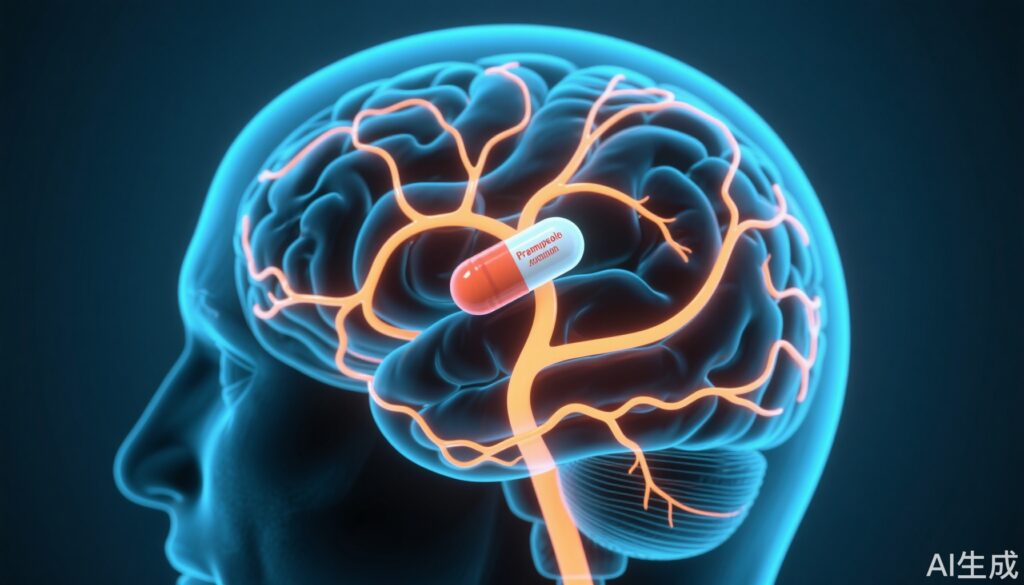Highlights
1. Pramipexole augmentation significantly reduces depressive symptoms at 12 weeks in patients with treatment-resistant unipolar depression compared to placebo.
2. The trial employed a robust multicentre, double-blind, placebo-controlled randomised design involving 150 participants across nine NHS Trusts.
3. While effective, pramipexole was associated with some adverse effects, including impulse control difficulties and symptoms of mania.
4. Findings support pramipexole as a promising augmentation strategy, warranting further head-to-head comparisons with established treatments.
Clinical Background and Disease Burden
Major depressive disorder (MDD) is a leading cause of disability worldwide. Approximately 30% of patients treated with standard antidepressants do not achieve adequate symptom relief, constituting treatment-resistant depression (TRD). TRD presents a significant clinical challenge, with limited effective augmentation strategies. Pramipexole, a dopamine D2/D3 receptor agonist primarily used in Parkinson’s disease, has shown potential antidepressant effects due to its dopaminergic modulation, which may address anhedonia and motivational deficits commonly seen in TRD. However, evidence regarding its efficacy and safety as an antidepressant augmentation agent remains scarce, necessitating rigorous clinical trials to evaluate its therapeutic value and tolerability in this population.
Research Methodology
This study was a multicentre, randomized, double-blind, placebo-controlled trial conducted across nine NHS Trusts in England. Adults diagnosed with treatment-resistant major depressive disorder were randomly assigned (1:1) to receive pramipexole titrated to a target dose of 2.5 mg daily or matching placebo, added to their existing antidepressant regimen. Randomisation was managed via an online system, and participants, investigators, and outcome assessors remained blinded throughout the study, except for the central pharmacy dispensing team.
The primary outcome was the change from baseline to 12 weeks in depressive symptom severity, measured using the 16-item Quick Inventory of Depressive Symptomology self-report version (QIDS-SR16). Secondary outcomes included longer-term symptom changes at 48 weeks, response and remission rates at 12 weeks, clinician-rated depressive scores (QIDS-C), measures of anhedonia (SHAPS), anxiety (GAD-7), functional impairment (WSAS), and treatment satisfaction (TSQM-9). Safety outcomes encompassed adverse event monitoring, medication discontinuation rates, impulse control symptoms (QUIP-RS), and mania/psychosis symptoms (ALTMAN). Suicidality was assessed via QIDS-SR16 item 12. Data were analyzed on an intention-to-treat basis, incorporating all eligible randomized participants. People with lived experience contributed to the study’s design and interpretation, enhancing its patient-centered approach.
Key Findings
Between February and May 2024, 217 individuals were screened; 151 participants were randomized (75 to pramipexole, 75 to placebo, after excluding one post-randomization ineligible participant). The cohort comprised 56% females and had a mean age of 44.9 years. Ethnicity data were unavailable.
At 12 weeks, pramipexole augmentation resulted in a statistically significant greater reduction in QIDS-SR16 total scores compared to placebo, indicating improved depressive symptoms. The scale ranges from 0 to 27, with higher scores reflecting more severe depression; the mean baseline severity was within moderate to severe range. The improvement observed supports the rapid antidepressant effect of pramipexole within the acute treatment phase.
| Pramipexole group (n=75) | Placebo group (n=75) | Treatment effect (95% CI) | Standardised mean difference (95% CI) | p value | ||
|---|---|---|---|---|---|---|
| Outcomes at week 12 | ||||||
| Primary efficacy endpoint | ||||||
| Change from baseline to week 12 in QIDS-SR16 total score (mean [SD]) | −6·4 (4·9) | −2·4 (4·0) | −3·91 (−5·37 to −2·45)* | −0·87 (−1·20 to −0·55) | <0·0001 | |
| Secondary efficacy endpoint | ||||||
| QIDS-SR16 response rate at week 12† | 30/68 (44%) | 11/67 (16%) | 2·72 (1·49 to 4·95)‡ | 0·62 (0·28 to 0·96) | 0·0011 | |
| QIDS-SR16 remission rate at week 12§ | 19/68 (28%) | 5/67 (8%) | 3·94 (1·61 to 9·64)‡ | 0·56 (0·22 to 0·90) | 0·0026 | |
| Change from baseline to week 12 in QIDS-C total score (mean [SD]) | −6·1 (4·5) | −3·0 (4·9) | −3·26 (−4·67 to −1·86)* | −0·70 (−1·00 to −0·40) | <0·0001 | |
| Change from baseline to week 12 in SHAPS total score (mean [SD]) | −3·8 (4·0) | −1·5 (3·6) | −2·20 (−3·41 to −1·00)* | −0·58 (−0·89 to −0·26) | 0·0003 | |
| Change from baseline to week 12 in GAD-7 total score (mean [SD]) | −4·1 (5·5) | −1·5 (4·7) | −2·51 (−3·97 to −1·06)* | −0·49 (−0·78 to −0·21) | 0·0007 | |
| Outcomes at week 48 | ||||||
| Number of patients in study by week 48 | 40 | 39 | . | . | . | |
| Change from baseline to week 48 in QIDS-SR16 total score (mean [SD]) | −6·1 (6·0) | −4·0 (5·1) | −2·02 (−3·73 to −0·31)* | −0·36 (−0·67 to −0·06) | 0·021 | |
| Change from baseline to week 48 in WSAS total score (mean [SD]) | −6·8 (11·4) | −3·3 (6·9) | −3·23 (−6·18 to −0·27)* | −0·34 (−0·66 to −0·03) | 0·03 | |
Secondary outcomes suggested sustained benefits at 48 weeks, with higher response and remission rates in the pramipexole group. Improvements were also noted in clinician-rated depression scales, anhedonia, anxiety symptoms, and functional impairment, though the magnitude of these effects varied.
Treatment satisfaction was higher with pramipexole, albeit tempered by an increased frequency of adverse events. Safety monitoring revealed some participants developed impulse control difficulties, as measured by QUIP-RS, and symptoms of mania or psychosis, measured by ALTMAN, consistent with dopaminergic pharmacodynamics. Despite these, medication discontinuation due to intolerance was relatively low, supporting acceptable tolerability in a specialist clinical setting.
Measures of suicidality did not show significant worsening, alleviating concerns about increased suicide risk with pramipexole augmentation in this cohort.
Mechanistic Insights and Biological Plausibility
Pramipexole’s mechanism involves selective agonism of dopamine D2 and D3 receptors, enhancing dopaminergic neurotransmission particularly in the mesolimbic pathway implicated in reward and motivation. This pharmacological profile is hypothesized to counteract anhedonia and motivational deficits resistant to serotonergic or noradrenergic antidepressants. The observed clinical improvements align with this biological rationale, providing translational support for dopaminergic modulation as a therapeutic target in TRD.
Controversies and Limitations
While this trial demonstrates efficacy, several limitations are noted. Ethnicity data were unavailable, limiting generalizability across diverse populations. The target dose of 2.5 mg, though based on prior data, may not represent an optimal therapeutic window for all patients. The study did not directly compare pramipexole against other augmentation strategies such as lithium or atypical antipsychotics, leaving comparative effectiveness undetermined. The occurrence of impulse control disorders and mania symptoms, though monitored, necessitates cautious clinical use and longer-term safety evaluation. Finally, patient adherence and real-world applicability outside specialist centers require further investigation.
Conclusion
This landmark UK-based randomized controlled trial establishes pramipexole augmentation as a clinically effective option for reducing depressive symptoms in treatment-resistant unipolar depression during the acute treatment phase. Its dopaminergic mechanism offers a novel approach addressing unmet needs in this challenging population. However, its use should be balanced against potential adverse effects, with vigilant monitoring required. Future research should focus on comparative trials with existing augmentation agents, longer-term safety, and exploration of biomarkers predicting response to optimize personalized treatment strategies.
References
1. Browning M, Cowen PJ, Galal U, et al; PAX-D study group. Pramipexole augmentation for the acute phase of treatment-resistant, unipolar depression: a placebo-controlled, double-blind, randomised trial in the UK. Lancet Psychiatry. 2025 Aug;12(8):579-589. doi:10.1016/S2215-0366(25)00194-4 IF: 24.8 Q1 .2. Rush AJ, Trivedi MH, Wisniewski SR, et al. Acute and longer-term outcomes in depressed outpatients requiring one or several treatment steps: a STAR*D report. Am J Psychiatry. 2006 Nov;163(11):1905-17.
3. Snaith RP, Hamilton M, Morley S, et al. A scale for the assessment of hedonic tone the Snaith-Hamilton Pleasure Scale. Br J Psychiatry. 1995 Jul;167(1):99-103.
4. Spitzer RL, Kroenke K, Williams JB, Löwe B. A brief measure for assessing generalized anxiety disorder: the GAD-7. Arch Intern Med. 2006 May 22;166(10):1092-7.
5. Mundt JC, Marks IM, Shear MK, Greist JH. The Work and Social Adjustment Scale: a simple measure of impairment in functioning. Br J Psychiatry. 2002 May;180:461-4.
6. MedlinePlus. Pramipexole. https://medlineplus.gov/druginfo/meds/a605032.html (accessed June 2025).


00194-4/asset/c6f7f094-5330-4623-9ebf-8d1f84476978/main.assets/gr2.jpg)

